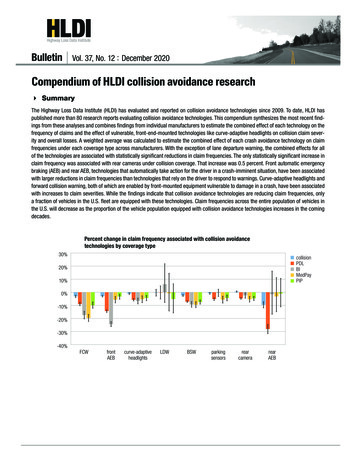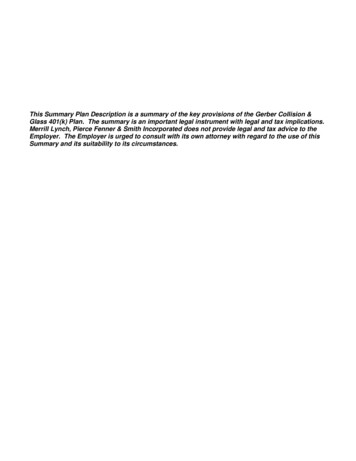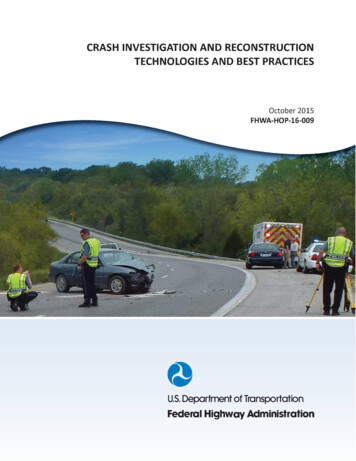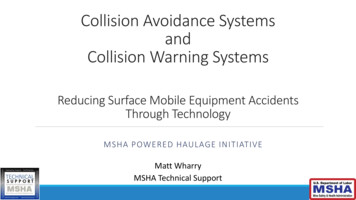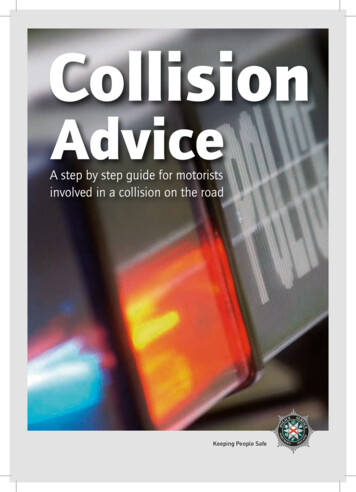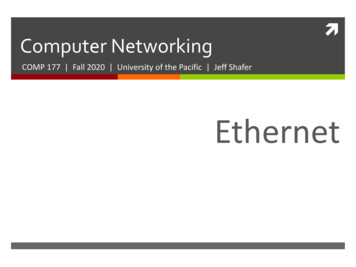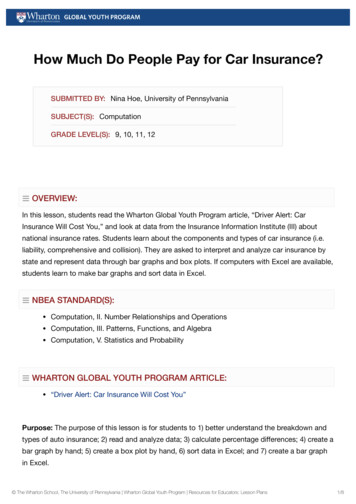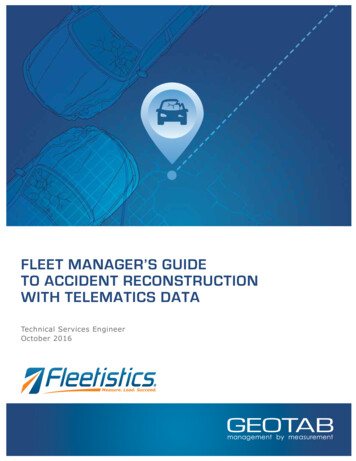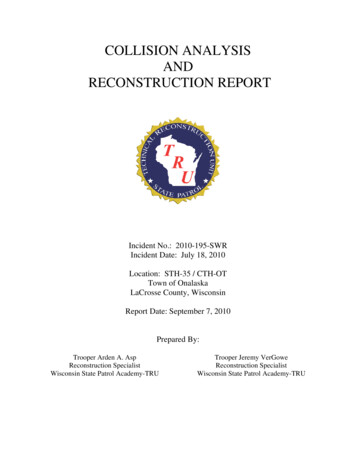
Transcription
COLLISION ANALYSISANDRECONSTRUCTION REPORTIncident No.: 2010-195-SWRIncident Date: July 18, 2010Location: STH-35 / CTH-OTTown of OnalaskaLaCrosse County, WisconsinReport Date: September 7, 2010Prepared By:Trooper Arden A. AspReconstruction SpecialistWisconsin State Patrol Academy-TRUTrooper Jeremy VerGoweReconstruction SpecialistWisconsin State Patrol Academy-TRU
TABLE OF CONTENTSSYNOPSIS . 3OBJECTIVE . 3CRASH SCENE . 4SCENE DOCUMENTATION. 5VEHICLE EXAMINATIONS. 6 2010 FORD CROWN VICTORIA: . 62001 PONTIAC GRAND AM: . 7COLLISION SEQUENCE . 8DRIVER / WITNESS STATEMENT SUMMARIES . 11SPEED ANALYSIS . 12MATHEMATICAL ANALYSIS: . 12EVENT DATA RECORDERS: . 12 2001 PONTIAC GRAND AM: . 12 2010 FORD CROWN VICTORIA. 13DIGITAL VIDEO RECORDER: . 14ENVIRONMENTAL FACTORS . 15WEATHER: . 15SUN/MOON POSITION . 15ROADWAY . 15HUMAN FACTORS . 16 DEPUTY STRATMAN. 16BRANDON JENNINGS . 17INVESTIGATION SUMMARY . 18INFORMATION REVIEWED FOR REPORT PREPARATION . 20 PRINTED MATERIAL(S) AND POLICE REPORTS . 20WISCONSIN STATE PATROL REPORTS . 20WITNESS / DRIVER STATEMENTS . 20VEHICLE DATA . 21 COMPUTER SOFTWARE/DATA .211.COMPUTER PROGRAMS . 212.PROFESSIONAL WEBSITES . 22 GEODIMETER TOTAL STATION SURVEYS .221.SCENE SURVEYS . 222.VEHICLE DAMAGE MEASUREMENTS . 22 PHOTOGRAPHS .221.2.3.APPENDIX . 232010-195-SWRPage 2 of 23
SYNOPSISOn July 18, 2010 at approximately 1:08 A.M., a motor vehicle collision occurredbetween a 2010 Ford Crown Victoria squad car and a 2001 Pontiac Grand Am. The crashoccurred on STH-35 in LaCrosse County, WI. The driver of the Pontiac sustained fatal injuriesas a result of the crash.CRASH SCENEOBJECTIVEAn analysis of the collision was completed using the available physical evidencecollected from the scene of the crash. The objective of the analysis was to establish the speedand positioning of the vehicles through the collision sequence. A review of any other highway,human, vehicle, or environmental factors that may have contributed to the collision was alsoperformed.2010-195-SWRPage 3 of 23
CRASH SCENEThe collision occurred at the intersection of STH-35 and CTH-OT in the Township ofOnalaska, LaCrosse County, Wisconsin (See Figure 1). STH-35 is a two-lane highway thattraverses the collision area in the north/south direction. The roadway is divided by a yellowcenterline which creates one lane of traffic for each direction of travel. As the highwayapproaches the intersection with CTH-OT from either direction, the individual traffic laneexpands to three lanes. For each respective direction of travel, the outside lanes are designated tobe used by traffic intending to turn right onto CTH-OT. Similarly, the inside lanes are intendedfor traffic turning left onto CTH-OT. Traffic traveling straight through the intersection isrequired to use the center lane which is approximately 15 feet wide. The individual turn lanesare approximately 11 feet wide and are separated from the center lane by solid white lane lines.White fog lines mark the outside edge of the right-turn lanes, while yellow paint lines establishthe inside edges of the left-turn lanes.As the highway begins to travel away from theintersection, each direction of travel reverts back down to a single 15 foot wide traffic lane. Inthe immediate vicinity of the intersection, the northbound lanes are separated from thesouthbound lanes by a slightly raised concrete median. STH-35 is relatively straight and flat as itpasses through the collision scene, and is regulated by a 55-mph speed limit in this area.NCTH-OTSTH-35FIGURE 1This aerial photograph obtained from Bing Maps provides an overview of the intersection betweenSTH-35 and CTH-OT. The picture illustrates the general design and setting of the two intersecting roadways.The photo was not taken on the day of the crash and is not intended to depict the conditions at that time.North is towards the top of the photo.CTH-OT is a four-lane roadway as it approaches STH-35 from the east. The roadway isdivided by a yellow centerline which creates two lanes of traffic for each direction of travel. Theindividual travel lanes are about 12 feet wide and are separated by dashed, white lane-lines. As2010-195-SWRPage 4 of 23
westbound traffic approaches the intersection, the outside lane becomes a turn only lane formotorists intending to proceed north on STH-35. Traffic intending to continue straight or turnsouth must use the inside lane. The westbound traffic lanes have a slight upward grade(Approximately 1%) as they approach the intersection. CTH-OT is a two-lane roadway as itextends away from the intersection to the west. CTH-OT intersects STH-35 at nearly a 90degree angle, and is regulated with a 25-mph speed limit. The intersection is controlled bytraffic lights that were operational at the time of the crash.SCENE DOCUMENTATIONA Geodimeter Total Station was used to map the collision scene. A total station is anelectronic instrument composed of three primary components. The unit contains a theodolite(angle measuring system), an EDM (electronic distance measuring system), and a data collector(electronic memory). The two measuring systems allowthe user to collect accurate three-dimensional data onpoints of interest. The measurements are stored in theunit’s data collector, along with descriptive tags, until theycan be downloaded into a computer system for furtheranalysis. A prism (reflector), usually mounted to a pole, isused to mark evidentiary points so that their placement canbe measured by the instrument.The available physical evidence was mapped onJuly 18, 2010 at approximately 2:30 A.M. by Troopers KrisAnderson and Arden Asp. The total station was used todocument the placement of such things as tire marks, afluid trail, and vehicle final resting positions. In addition,the applicable portions of the intersecting roadways werealso mapped. The instrument was also used to survey thedamage profiles of the Ford Crown Victoria and thePontiac Grand Am. The measurements were stored in thedata collector and were later downloaded for the creationof a scaled scene drawing, which was used to complete thecollision analysis.- Intentionally Left Blank -2010-195-SWRPage 5 of 23
VEHICLE EXAMINATIONSThe collision vehicles were examined and photographed in order to document collisiondamage. The damage profiles were mapped with the total station. This information was usedalong with scene evidence to complete the collision analysis. 2010 Ford Crown Victoria:The Ford Crown Victoria was a four doorsedan powered by a 4.6 Liter, 8-cylinder engine.The power was provided at the rear wheelsthrough an automatic transmission. The vehiclewas equipped with disc brakes at all four wheelsand had an anti-lock brake system. The vehiclehad a frontal airbag system and the driver's sideairbag was deployed. This particular Ford CrownVictoria was being used as a police vehicle by theLa Crosse County Sheriff’s Department and wasoutfitted with emergency lighting and a siren.The primary contact damage was located atthe right front corner of the squad car. In thisarea the bumper exhibited inward and rearwardFIGURE 2displacement. The hood was also pushed backand severely creased (See Figure 2). The right front fender was displaced rearward andexhibited induced crumpling damage. The front passenger door was dented and creased. Therewas also some light abrading damage in the area where the passenger door meets the frontfender.The right front wheel was displaced rearward and was no longer free to roll. The rimexhibited severe damage. Theframe of the vehicle appearedto sag in the middle whenviewed from the right side ofthe car (See Figure 3). Therewas some relatively lightinduced creasing located inboth rear quarter panels nearthe base of the C-pillars andaround the rear wheel wells.The left rear rim was bent.The left front wheel exhibitedsevere contact damage andFIGURE 3was no longer free to roll.2010-195-SWRPage 6 of 23
2001 Pontiac Grand Am:The Pontiac Grand Am was a 2 door coupe equipped with a 3.4 Liter, 6-cylinder enginewhich powered the front wheels through an automatic transmission. The vehicle had an antilock brake system that featured disc brakes at thefront and drum brakes at the rear. The vehiclewas outfitted with frontal airbags and both weredeployed.The front of the Pontiac sustained extensivedamage. The primary contact appeared to be atthe front left fender of the vehicle. In this area,the fender and the front left portion of the coresupport exhibited inward displacement towardthe longitudinal centerline of the vehicle. Thefront left rim exhibited contact damage.Thevehicle's hood, head lamp assemblies, andfrontal body trim was missing. The front leftside of the bumper was detached and pulledoutward from the frame (See Figure 4).FIGURE 4The driver's door was bowed out from the original bodyline of the vehicle. Although the doorwas still attached at the hinge and Nader pin, there was a significant gap between the top of thedoor frame and the roof line of the vehicle (See Figure 5). The bowing damage was likely aresult of occupant loading against the door during the collision pulse. The opening allowed theunbelted driver to be ejected during its post-impact movement.The Grand Am showed evidence of a secondary impact at the right rear corner. The right taillamp assembly was missing from the vehicle, and there was light blue color transfer in the vacantcavity. The same color transfer was located on the right corner of the rear bumper cover. Thetrunk lid had been sprung and was missing from the vehicle (See Figure 6).FIGURE 52010-195-SWRFIGURE 6Page 7 of 23
COLLISION SEQUENCEA 2010 Ford Crown Victoria squad car, operated by Deputy Trisha Stratman, wastraveling northbound on STH-35 approaching the intersection with CTH-OT. Deputy Stratmanwas responding to a report of a bar fight at Smokey's Bar and Grill and was operating with heremergency lights and siren activated. Meanwhile, a 2001 Pontiac Grand Am, operated byBrandon Jennings, was approaching the same intersection from the east using CTH-OT (SeeFigure 7).NFIGURE 7The Pontiac proceeded to enter into the intersection in front of the approaching squad car.Based on witness statements and the available physical evidence, the Pontiac was attempting tocontinuewestboundthroughtheintersection. Before the Grand Am couldclear the intersection, it was impacted inthe front left fender by the front of theapproaching Ford. The impact occurred inthe center of the intersection where thenorthbound lane of STH-35 intersectedthe westbound lane of CTH-OT (SeeFigure 8). The approximate point ofimpact was evident by the start of curvedtire scrubs left by the Grand Am as itbegan to depart the collision.FIGURE 82010-195-SWRPage 8 of 23
Following the impact, the Pontiac Grand Am spun clockwise as it was forced primarilytowards the north. The Grand Am completed nearly three quick rotations before coming to restapproximately 124 feet north of the impact area. The Pontiac remained on the paved roadsurface during its post impact movement and ended up facing towards the southwest near theoutside pavement edge of northbound STH-35. The vehicle’s path of travel was evident bycurved tire marks left on the roadway as it moved to final rest (See Figure 9). Mr. Jennings wasejected from the vehicle during its pos-impact movement. He came to rest on the outsideshoulder of northbound STH-35, approximately 70 feet to the north of his vehicle, after striking aroad sign.FIGURE 9The Ford Crown Victoria also acquired a slight clockwise rotation as it departed thecollision primarily in a northern direction. After reaching the north side of the intersection, theleft front wheel of the squad car impacted a traffic light pole mounted in the concrete medianstrip. The pole broke away and the squad continued to depart slightly towards the northwest(See Figure 10). The Ford proceeded to cross the concrete median and entered into thesouthbound lanes of STH-35 approximately 140 feet north of the intersection. The vehicleeventually angled across the southbound lanes and came to rest just onto the outside shoulder ofsouthbound STH-35. The Ford Crown Victoria traveled approximately 461 feet from impactbefore coming to rest on the shoulder facing towards the northwest (See Figure 11). Thevehicle's post-impact movement was evident by scrape marks, tire marks, and a fluid trail.2010-195-SWRPage 9 of 23
FIGURE 10FIGURE 112010-195-SWRPage 10 of 23
DRIVER / WITNESS STATEMENT SUMMARIESThe following individuals gave statements to investigators from the Wisconsin StatePatrol regarding the collision being investigated. This section is only intended to summarizetheir observations regarding the incident. David Weis – Mr. Weis noted that he lives at the corner of Rider's Club Road and STH35. He stated that he observed the squad car go by with its lights and siren activated justprior to the crash while watching television in his living room. He indicated that thissquad was going through the area faster than any he had seen in 35 years. He noted that asecond squad came through at a slower speed a short time later. Gary A. Spors – Mr. Spors stated that the squad car passed him on STH-35 just pastCTH-Z. He estimated that the squad was going at least 120-mph. He felt it was "crazy"for the squad car to be going that fast in the rain. James Mayer – Mr. Mayer stated that he was at home when he heard the crash occur. Hedid not recall hearing a siren or observing any emergency lights from a squad car. Henoted that he went to the scene and took some video footage of the squad after hearingthe crash. Trisha Stratman – Deputy Stratman was the operator of the squad car involved in thecollision. She stated that she was operating in emergency mode and remembered brakingas she traveled into the intersection of STH-35 and CTH-OT. She indicated that she didnot remember much else. Ashley F. Rochester – Ms. Rochester stated that she was approaching CTH-OT from thenorth when she observed the northbound squad car approaching from the oppositedirection with its emergency lights activated. She indicated that she could not hear asiren, but noted that her windows were rolled up with the car radio and air conditioningon. Ms. Rochester indicated that the traffic light was green for her and the squad car.She stated that she witnessed the crash and had to come to a stop as the squad car enteredinto the southbound lanes and crossed in front of her vehicle. Angela S. Berkley – Ms. Berkley stated she was traveling westbound on CTH-OT. Sheindicated that she observed the squad car to the south, but thought that she had time tocross in front of it. After clearing the intersection, she looked in her mirrors and sawsparks flying from the crash. She noted that she never heard a siren. Benjamin J. Weigel – Mr. Weigel stated that the squad car had passed him at a very highrate of speed. He indicated that he observed the squad car continue up to the intersectionof CTH-OT after passing him. He noted that the squad's lights then disappeared. Afterreaching the intersection, he observed crash debris. He did not observe the collision.2010-195-SWRPage 11 of 23
SPEED ANALYSISMathematical Analysis:The Principle of the Conservation of Momentum approach was used to solve for theimpact speeds of the Ford Crown Victoria and the Pontiac Grand Am. The method is dependantupon the approach angles, departure angles, weights, and post impact speeds of the involvedvehicles. The approach and departure angles are determined from the damage profiles of thevehicles and the physical evidence left at the scene of the crash. The physical evidence oftenconsists of such things as tire marks, scrape marks, gouges, and fluid trails. A vehicle’s postimpact speed is dependant upon the distance the vehicle traveled from impact to final rest, andthe drag factor assigned to the vehicle for the particular surface(s) that it traveled over. The dragfactors used take into consideration such things as surface type, surface slope, vehicle slipangles, and vehicle tires that are locked due to damage.Using the Conservation of Momentum approach, the impact speed of the Ford CrownVictoria was estimated to be approximately 86 to 90-mph. The Pontiac Grand Am was estimatedto be traveling approximately 15 to 22-mph at impact. The calculated impact speed of the GrandAm was found to be somewhat sensitive to the departure angle of the Crown Victoria. Therewas no initial tire mark evidence available to determine a relatively precise departure angle forthe squad car. However, the vehicle did strike a traffic light pole and eventually began to leavemarkings which did assist in narrowing its possible range of departure. There was no physicalevidence of pre-impact braking found on the roadway for either vehicle. The speed ranges arebased upon a sensitivity analysis of the input variables.Event Data Recorders: 2001 Pontiac Grand Am:A vehicle’s safety restraint system is generally monitored and controlled by adedicated electronic module. This unit is generally referred to as the (A)irbag (C)ontrol(M)odule. This electronic instrument “senses” a crash and makes the “decision” as towhether or not the airbags should be deployed. The module, which utilizes an internalaccelerometer to analyze and interpret sudden speed changes, may also record datasurrounding a collision event. For most General Motors vehicles manufactured in 2000or later, this may include pre-crash data such as vehicle speed, engine speed, percentthrottle, and brake switch circuit status.Since the 2001 Pontiac Grand Am's airbags were deployed during the collisionevent, a deployment file would be expected to have been written and locked into theACM's memory. Trooper Mike Marquardt downloaded the ACM from the Grand Am onJuly 19, 2010 using the Bosch Crash Data Retrieval System. He recovered a deploymentfile from the module which did contain pre-crash information. The data indicated that thevehicle had accelerated from 18-mph up to 20-mph during the seconds immediatelypreceding the deployment event (See Figure 12). This data is consistent with themomentum analysis that was performed.2010-195-SWRPage 12 of 23
FIGURE 12Figure 12 shows the vehicle speed data recovered from the 2001 Pontiac Grand Am's AirbagControl Module. The first column reports the time period prior to "Algorithm Enable" that theparticular row of data refers to. Algorithm Enable is the point in time when the modules sensingalgorithm "awakens." The algorithm then begins to evaluate the acceleration the module isexperiencing in order to determine if the vehicle's airbags should be deployed. Due to the manner inwhich the data is captured by the module, the highlighted time designation could actually beanywhere from approximately .001 seconds to 1.2 seconds prior to Algorithm Enable. The other timestamps would then go back in time at approximately 1 second intervals. 2010 Ford Crown VictoriaA vehicle's (P)ower-train (C)ontrol (M)odule monitors various input sources andsends signals to various components within the vehicle's power-train in order to achieveoptimum engine performance. While monitoring the power-train, the PCM continuouslyobtains information from such locations as the vehicle's speed sensor, throttle positionsensor, brake switch sensor, engine speed sensor, and antilock brake sensor. The PCM inthe 2010 Ford Crown Victoria contains an event data recorder that continuously stores thisdata in a circular memory buffer. This means that the data at the beginning of the bufferbegins to be overwritten once the allocated memory is full. A PCM will typically storeapproximately 25 seconds of data.Trooper Mike Marquardt downloaded the PCM from the Ford Crown Victoria onJuly 19, 2010 using the Bosch Crash Data Retrieval System. He recovered a PCM datafile which appeared to contain pre-crash data leading up to the collision event. The PCMfile showed the vehicle braking from a speed of 106-mph approximately 1.6 seconds priorto the collision event. The last speed recorded by the PCM was 90.6-mph (See Figure13). This data also appears to be consistent with the mathematical speed estimate. Formore information on the data collected from the collision vehicles, refer to TrooperWilliam Ryan's Event Data Recorder Analysis which is appended to this report.FIGURE 13Figure 13 charts the final seconds of data recorded by the Ford Crown Victoria's Powertrain Control Module leading up to the collision event.2010-195-SWRPage 13 of 23
Digital Video Recorder:The Ford Crown Victoria was outfitted with a Mobile-Vision video camera system. Inaddition to capturing and recording video in digital format, the video camera system also recordssquad position using a GPS receiver. The system can then compute and display the squad'sspeed based on the time it takes the vehicle to change position. The video and speed datarecorded by the system ended shortly before the squad car entered into the intersection andimpacted the Pontiac Grand Am. The remaining digital data leading up to impact was likelymissing due to a power loss caused by the collision. In other words, the system likely did nothave enough time to record the data to permanent memory prior to the power loss. The systemdid indicate that the squad was traveling approximately 104-mph just prior to entering theintersection. This speed recording does appear to be consistent with the data recovered from theFord's Power-train Control Module (See Figure 14).FIGURE 14Figure 14 illustrates an approximate time/distance relationship between the Ford and the Pontiacbased on information retrieved from the event data recorders of the collision vehicles. The Ford wasapproximately 190 feet from the intersection about 1.4 seconds prior to impact. The squad was travelingabout 104 to 105-mph at this time. Meanwhile, the Pontiac was just starting to cross the white stop line andwas approximately 39 feet from impact. The Pontiac was traveling at a rate of approximately 19 to 20-mph.This spatial relationship appears to be relatively consistent with the final video footage and speed datarecovered from the squad's onboard digital video recorder.2010-195-SWRPage 14 of 23
ENVIRONMENTAL FACTORSWeather:Historical weather data recorded at the nearby LaCrosse Municipal Airport indicates thesky was partly cloudy around the time of the crash. The temperature was approximately 69 ºFwithout any significant winds blowing (See Figure 15). There was light rain reported during theapproximately 2 hour time period leading up to the crash. The atmospheric conditions were clearand should not have caused any visibility problems. Visibility was reported at the maximumvalue of 10 miles.FIGURE 15Figure 15 charts the weather conditions in the Onalaska area during the hours surrounding thecrash.The data was recorded at the LaCrosse Municipal Airport and was obtained fromwww.weatherunderground.com. The highlighted line is the data entry that is closest to the approximatetime of the crash.Sun/Moon PositionAccording to records kept by the United States Naval Observatory, neither the sun ormoon were visible in the sky around the time of the crash. The drivers were operating duringnight time hours, but street lamps did provide some ambient lighting.RoadwayThe roadway was composed of concrete and appeared to be in relatively good condition.The road surface contained no significant abnormalities in the general area of the collision. Thepaved surface was wet due to light precipitation preceding the crash. The paint lines did exhibitsome fading in the area of the collision, but were visible.2010-195-SWRPage 15 of 23
HUMAN FACTORS Deputy StratmanBased on digital video footage recovered from the Ford's onboard camera, the squad carhad just passed the intersection of Westview Drive when the traffic lights at the intersection ofCTH-OT turned yellow for motorists on STH-35. This occurred around 11 seconds prior toimpact. The Mobile-Vision video camera system and the Ford's Power-train Control Moduleindicate the vehicle was traveling at a speed of around 115-mph at this time. Around 4.5 secondslater, the traffic lights turned red. The video footage shows that the squad had just passedCloverdale Road and was approaching Penney Lane when the light change occurred. PCM dataand Mobile-Vision data indicate the squad was traveling approximately 114 to 115-mph at thistime (See Figure 16). Although the PCM data indicates that Deputy Stratman released theaccelerator pedal around this time and allowed the vehicle to begin to gradually slow, she wasstill traveling around 107-mph as she approached to within a few hundred feet of the intersectionwhile facing a red traffic light. Although she was traveling in emergency mode, her decision notto significantly reduce her speed severely limited the time and distance available to react to apotential hazard. Moreover, there would seem to be a greater chance that an unsuspectingmotorist would enter into the intersection when the traffic lights are green for their direction oftravel.YellowRedCTH-OTPenney LaneWestview DriveCloverdaleFIGURE 16Figure 16 illustrates the approximate locations of the Ford Crown Victoria when the traffic lightschanged color for northbound traffic at the intersection of CTH-OT. When the traffic lights t
RECONSTRUCTION REPORT Incident No.: 2010-195-SWR Incident Date: July 18, 2010 Location: STH-35 / CTH-OT Town of Onalaska LaCrosse County, Wisconsin Report Date: September 7, 2010 Prepared By: Trooper Arden A. Asp Reconstruction Specialist Wisconsin State Patrol Academy-TRU Trooper Jeremy VerGowe Reconstruction Specialist
